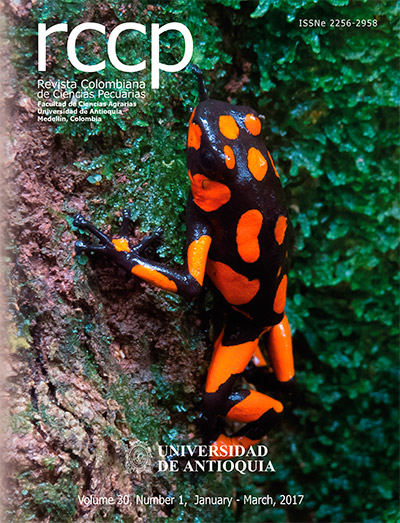Anesthetic use of eugenol and benzocaine in juveniles of red tilapia (Oreochromis sp.)
DOI:
https://doi.org/10.17533/udea.rccp.v30n1a07Keywords:
anesthesia, cortisol, fish, handling, recovery, stressAbstract
Background: routine practices such as biometrics, transportation and medical procedures are a source of stress to fish. The use of anesthetics is recommended to reduce undesirable effects of stress, such as decreased feed intake and even mortality -in critical cases. Objective: the aim of this study was to determine the anesthetic efficacy of eugenol and benzocaine in juveniles of red tilapia Oreochromis sp. Methods: thirty juveniles of red tilapia (Oreochromis sp.) were distributed in groups of 10 individuals as follows; G1: eugenol (50 mg/L), G2: eugenol (100 mg/L) and G3: benzocaine (100 mg/L). The fish were individually placed in the corresponding anesthetic solution. After immersion, times to achieve the different anesthetic stages were recorded. During anesthesia, the fish were measured, weighed and blood samples were collected for glucose and plasma cortisol analysis. Results: time to total loss of equilibrium was higher in G3 (p<0.05) compared to the other two groups. No significant differences were observed among groups regarding time to total loss of equilibrium or time to ventilation absence. Glucose levels were significantly higher in G1 (p = 0.03) in comparison to G3. However, cortisol levels were higher in G3 as compared to the other groups (p<0.05). A mortality rate of 10% was observed in G1 fish. Conclusion: current findings indicate that 100 mg/L eugenol leads to induction of anesthesia in less than 3 min and recovery in less than 5 min, without mortality in juveniles of red tilapia.
Downloads
References
Corredor AS, Landines, MA. Efecto del ácido ascórbico sobre la respuesta de los peces ante condiciones de estrés. Rev Med Vet Zoot 2009; 56:53-66.
Giaquinto, PC, Volpato, GL. Chemical communication, agression, and conspecific recognition in the fish nile tilapia. Physiol Behav 1997; 62 (6):1333-1338.
Inoue LAKA, Afonso LOB, Iwama GK, Moraes G. Effects of clove oil on the stress response of matrinxã (Brycon cephalus) subjected to transport. Acta Amazônica 2005; 35:289-295.
Iversen M, Finstad B, McKinley RS, Eliassen RA. The efficacy of metomidate, clove oil, Aqui-Sk and BenzoakR as anaesthetics in Atlantic salmon (Salmo salar L.) smolts, and their potential stress-reducing capacity. Aquac Res 2003; 221:549-566.
Iversen M, Eliassen R, Finstad B. Potential benefit of clove oil sedation on animal welfare during salmon smolt, Salmo salar L. transport and transfer to sea. Aquac Res 2009; 40 (2):233-241.
Noga EJ. Fish Disease. Diagnosis and treatment. 2nd ed. Iowa: Wiley-Blackwell; 2010.
Okamoto MH, Tesser MB, Louzada LR, dos Santos RA, Sampaio LA. Benzocaína e Eugenol como anestésicos para juvenis do pampo Trachinotus marginatus. Ciência Rural, Santa Maria 2009; 39 (3):866-867.
Oliveira JR, do Carmo JL, Cavalcanti KK, Figeredo MC. Cloreto de sódio, benzocaína e óleo de cravo-da-índia na agua de transporte de tilápica-do-nilo. Rev Bras Zootecn 2009; 38 (7):1163-1169.
Palic D, Herolt DM, Andreasen CB, Menzel BW, Roth JA. Anesthetic efficacy of tricaine methanesulfonate, metomidate and Eugenol: Effects on plasma cortisol concentration and neutrophil function in fathead minnows (Pimephales promelas Rafinesque, 1820). Aquaculture 2006; 254 (1-4):675-685.
Park MO, Im SY, Seol DW, Park IS. Efficacy and physiological responses of rock bream, Oplegnathus fasciatus to anesthetization with clove oil. Aquaculture 2009; 287 (3-4):427-430.
Pereira-da-Silva EM, de Oliveira RHF, Ribeiro MAR, Coppola MP. Efeito anestésico do óleo de cravo em alevinos de lambari. Ciência Rural, Santa Maria 2009; 39 (6):1851-1856.
Pirhonen J, Schreck CB. Effects of anaesthesia with MS-222, clove oil and CO2 on feed intake and plasma cortisol in steelhead trout (Oncorhynchus mykiss). Aquaculture 2003; 220 (1-4):507-514.
Pohlert T. The Pairwise multiple comparison of mean ranks package (PMCMR). 2014. R package. Ross LG, Ross B. Anesthetic and Sedative Techniques for Aquatic Animals. Edinburgh: Blackwell publishing editorial; 2008.
Readman GD, Owen SF, Murrell JC, Knowles TG. Do Fish Perceive Anaesthetics as Aversive? PLoS ONE 2013; 8(9).
Roubach R, Gomes LC, Leão Fonseca FA, Val AL. Eugenol as an efficacious anaesthetic for tambaqui, Colossoma macropomum(Cuvier). Aquac Res 2005; 36 (11):1056-1061.
Soto CG. Clove oil as a fish anaesthetic for measuring length and weight of rabbitfish (Siganus lineatus). Aquaculture 1995; 136:149-152. Stoskopf, M. Fish medicine. Saunders Company. 1993.
Velíšek J, Stejskal V, Kouřil J, Svobodov Zk. Comparison of the effects of four anaesthetics on biochemical blood profiles of perch. Aquac Res 2009; 40 (3):354-361.
Vidal LVO, Albinati RCB, Albinati ACL, Lira ADd, Almeida TRd, Santos GB. Eugenol como anestésico para a tilápia-do-nilo. Pesqui Agropecu Bras 2008; 43:1069-1074.
Vidal LVO, Furuya WM, Graciano TS, Shamber C, Silva LCR, Santos LD, Santos SR. Eugenol como anestésico para juvenis de matrinxã (Brycons cephalus). Rev Bras Saúde e Produção Anim 2007; 8 (4):335-342.
Wagner GN, Singer TD, McKinley RS. The ability of clove oil and MS-222 to minimize handling stress in rainbow trout (Oncorhynchus mykiss Walbaum). Aquac Res 2003; 34 (13): 1139.
Wendelaar Bonga SE. The stress response in fish. Physiol Rev 1997; 77:591-625. Woolsey J, Holcomb M, Ingermann RL. Effect of temperature on clove oil anesthesia in steelhead fry. N Am J Aquacult 2004; 66:35-41.
Downloads
Published
How to Cite
Issue
Section
License
Copyright (c) 2016 Revista Colombiana de Ciencias Pecuarias

This work is licensed under a Creative Commons Attribution-NonCommercial-ShareAlike 4.0 International License.
The authors enable RCCP to reprint the material published in it.
The journal allows the author(s) to hold the copyright without restrictions, and will allow the author(s) to retain publishing rights without restrictions.









